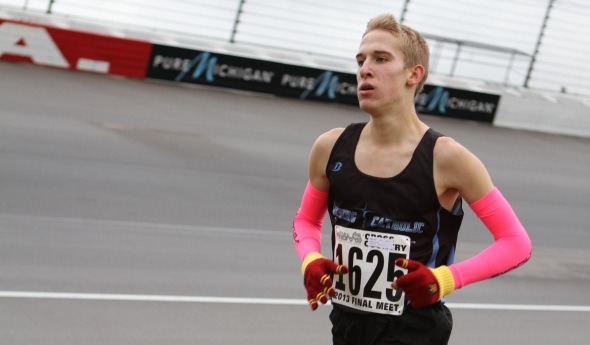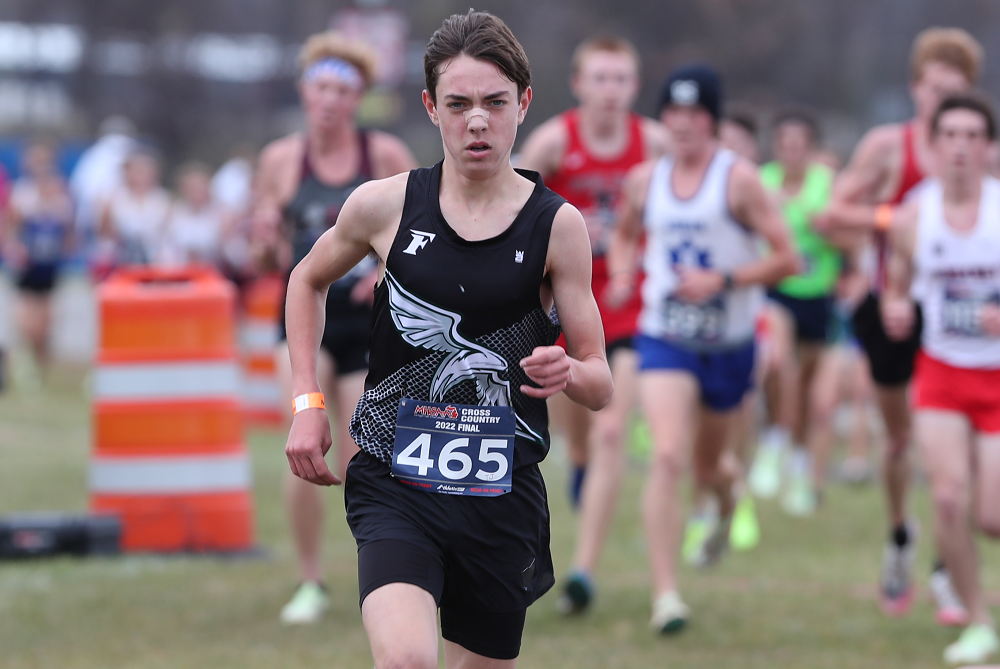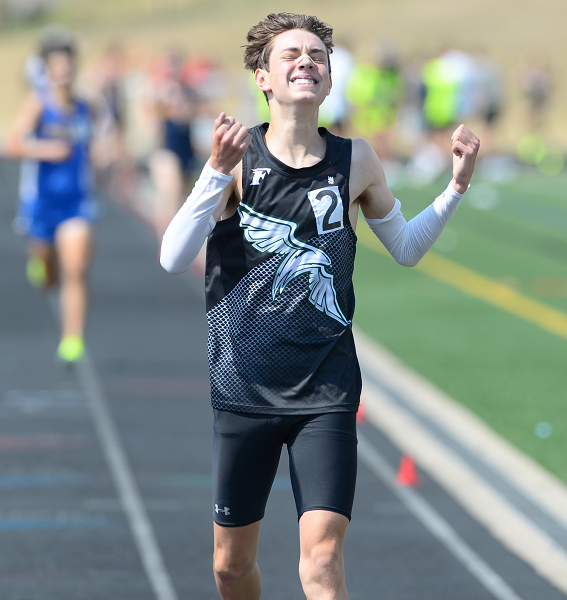
Changes Pay Off for D3 Boys Champ
November 2, 2013
By Bill Khan
Special to Second Half
BROOKLYN — It wasn't all putting in extra miles and running at a higher intensity.
For Lansing Catholic junior Keenan Rebera, it was going to take a lifestyle change if he was going to climb the final four places to become the MHSAA Lower Peninsula Division 3 cross country champion.
The changes paid off for Rebera, who cruised to the Division 3 title with a time of 15:31.0 on a mud-slicked Michigan International Speedway course on Saturday.
A year ago, Rebera took fifth at MIS in 15:42.5, 37.4 seconds out of first place. He made it a point to get at least eight hours of sleep and cut out anything acidic from his diet, including soda.
"I was really sick last year when I ran, so I made some changes in the way I trained, the way I slept and the way I ate," he said. "I'm a lot healthier. I have more energy. I came back here with a grudge against this course."
Chase Barnett of Mason County Central shot out to the lead before Rebera reeled him in and began to open up an insurmountable gap as he ran the first mile in 4:40. Barnett finished second in 16:00.9.
"After that first hill, I sped up," Rebera said. "I realized it was going to be a little bit slow, so I wanted to keep up the pace."
The third mile was the roughest of the race, he said. Not only was fatigue mounting, but runners went through the muddiest part of the course. The pain went away as Rebera took what was essentially a victory lap down the long straightaway at MIS.
"It hurt really bad right before that, but when people started cheering there and there was a little less mud, it felt good," he said.
Rebera is the second Lansing Catholic runner in the last three years to win the individual title. Zachary Zingsheim was the school's first MHSAA champ two years ago in 15:48.2.
Rebera was hoping his performance would lead the Cougars to a team championship, but they took third with 189 points.
The Benzie Central dynasty rolled to another championship by a 111-129 margin over runner-up Stockbridge.
It was the seventh title for Benzie Central, which has cracked the top 10 for 20 straight years.
The Huskies returned five runners from a team that took fourth last season for the second year in a row. A huge addition was freshman Brayden Huddleston, who was the team's No. 2 runner and 17th among team runners in 16:41.5. Junior Kyle Bradley led Benzie, taking 14th among team runners in 16:39.4.
Also scoring for the Huskies were senior Max Gaft (19th, 16:48.1), senior Ismael Halaweh (30th, 17:07.9) and sophomore Jake Williams (31st, 17:08.3). Williams' performance made a huge difference, as he came in 27 places ahead of Stockbridge's No. 5 runner among team finishers.
PHOTO: Lansing Catholic's Keenan Rebera rounds the bend at MIS on the way to winning the LP Division 3 championship Saturday. (Click for more from RunMichigan.com.)

Freeland's Hansen Not Focused on Joining All-Time Greats - But On His Way
By
Paul Costanzo
Special for MHSAA.com
September 29, 2023
The goal written on Matt Kaczor’s Post-It Note was sub-15 minutes, 15 seconds. That’s what the Freeland cross country coach was hoping for from star runner TJ Hansen during his junior season.
 Kaczor tore it up after seeing Hansen run a single race this fall.
Kaczor tore it up after seeing Hansen run a single race this fall.
“Knowing what he did over the summer and where he was at, seeing what his 1,600 (meter) and his mile got down to, I had a feeling he could get under 15:30 quickly,” Kaczor said. “After the first race, I looked at my assistant and was like, ‘I’ve gotta rip up that Post-It Note. I don’t think our goal is on the level of where he’s at right now.’ At first, it was break 15:15. Once I saw him race at the Under the Lights (on Aug. 18 at St. Johns), I was like, ‘Yeah, he’s going sub 15.’”
Hansen ran 15:39.6 in that first race, and on Sept. 7, in Shepherd, he ran 15:13.9 to meet the goal written on the now-shredded Post-It Note.
This past Saturday, he ran 15:03.7 at the Cadillac Veterans Serving Veterans Invitational. It’s the fastest time recorded in Michigan this year, and a signal that Kaczor might be filling out a new Post-It Note before the season is out.
“The sub-15 barrier, that’s been something on my mind for a while,” Hansen said. “Now that I’m edging closer and closer to that, it’s been exciting. With how heavy my training has been, I wouldn’t expect (to have run this fast this early). Being able to run the times I am really paints the picture for what’s ahead.”
Hansen came into the season already regarded as one of the elite distance runners in the state. He won the 3,200 meters at the MHSAA Lower Peninsula Division 2 Track & Field Finals this past spring. He’s also finished all-state (12th and fifth, respectively) the past two seasons at the LPD2 Cross Country Finals.
His current trajectory, however, would put his name near some of the state’s all-time greats. But that’s not something Hansen is focusing on.
“I really don’t like to compare myself to others,” he said. “I don’t focus on that. I try to be the best TJ Hansen that I can be. The best version of myself.”
Focusing on himself is almost necessary for Hansen, as he’s spending a lot of time during his races running by himself.
At each of the big events Freeland has run in this season, Hansen has finished at least 20 seconds ahead of his nearest competitor. That includes all divisions of the Duane Raffin Festival of Races in Holly.
In Cadillac, where Hansen ran his current best time, he was a full minute ahead of the rest of the field.
 “He’s just a special athlete,” Kaczor said. “I can’t see Freeland having someone like this in a while. He’s a generational talent. What’s crazy is, I had the school record when he was a freshman. He and Braden (Honsinger) broke it last year. But TJ has now dropped that school record (set in 1998) by almost a minute.”
“He’s just a special athlete,” Kaczor said. “I can’t see Freeland having someone like this in a while. He’s a generational talent. What’s crazy is, I had the school record when he was a freshman. He and Braden (Honsinger) broke it last year. But TJ has now dropped that school record (set in 1998) by almost a minute.”
Hansen’s achievements have already put him on a path to run at the next level, which is something of a family tradition.
His older sisters Peyton and Kiera are track & field athletes at Wayne State and Eastern Michigan, respectively. Their parents, Tim and Pam, were track & field stars at Central Michigan.
TJ has drawn the attention of coaches around the country, including from Michigan, Michigan State, Wisconsin, Tennessee and Colorado.
Having family members who know the process is a help for Hansen, and he said they’ve all been good about allowing him to choose his own path, whatever that may be.
“He’s from a good family that knows how to work and knows how to get things done,” Kaczor said. “He knows that if he puts in the work, he’s going to be at a good spot.”
While Hansen admits it can be a bit overwhelming, he’s using it as motivation to run faster and continue to put his name out there.
Also serving as motivation is 2022 Division 2 champion Connell Alford of Chelsea. Alford is among the elite group of runners in Michigan who have broken the 15-minute mark, doing it twice a year ago.
He currently has the state’s second-best time behind Hansen’s this year, running 15:09.1 at the MSU Invitational on Sept. 15.
“Whenever I see him drop a time, my main goal is to run faster,” Hansen said. “Whenever I see him run a good time, that motivates me to work hard.”
The two won’t see each other until the MHSAA Finals on Nov. 4 at Michigan International Speedway. It’s an opportunity Hansen is excited for, as it’s a chance to race and be pushed toward the lofty goals he’s set for himself. Kaczor is excited about it, too, even if it might mean having to replenish his supply of Post-Its.
“We don’t talk about winning the state title; we talk about making sure that we have great races on those days,” Kaczor said. “We can’t control how somebody else runs. It’s a matter of can we, if the weather is right and the course is in good condition, can we be one of the few guys that has run in the 14s on that course? That’s the goal. Put yourself in some great categories with those upper echelons and the greats of all-time.”
 Paul Costanzo served as a sportswriter at The Port Huron Times Herald from 2006-15, including three years as lead sportswriter, and prior to that as sports editor at the Hillsdale Daily News from 2005-06. He can be reached at [email protected] with story ideas for Genesee, Lapeer, St. Clair, Sanilac, Huron, Tuscola, Saginaw, Bay, Arenac, Midland and Gladwin counties.
Paul Costanzo served as a sportswriter at The Port Huron Times Herald from 2006-15, including three years as lead sportswriter, and prior to that as sports editor at the Hillsdale Daily News from 2005-06. He can be reached at [email protected] with story ideas for Genesee, Lapeer, St. Clair, Sanilac, Huron, Tuscola, Saginaw, Bay, Arenac, Midland and Gladwin counties.
PHOTOS (Top) Freeland's TJ Hansen leads a pack during last season's LPD2 Final at Michigan International Speedway. (Middle) Hansen enjoys a moment of exhilaration after winning the 3,200 this spring at the LPD2 Finals at Ada Forest Hills Eastern. (Top photo by Carter Sherline/Run Michigan; middle photo by Dave McCauley/Run Michigan.)

